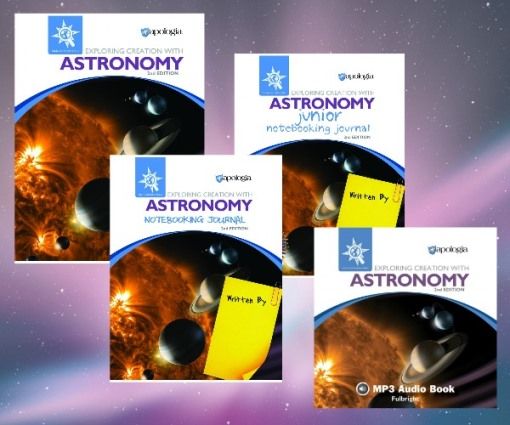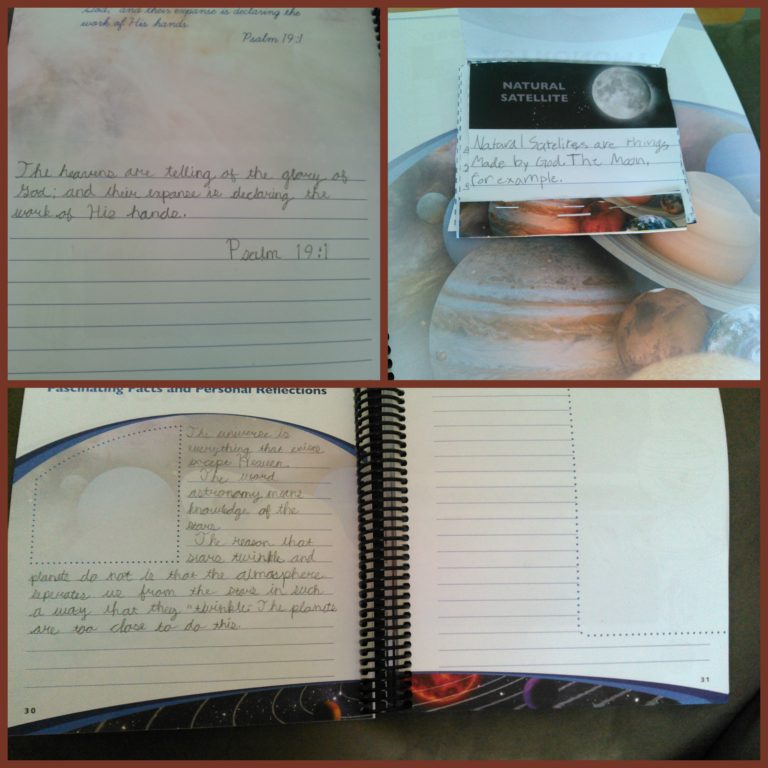If there’s one thing Apologia Educational Ministries is known for, it’s their science programs. I’ve always wanted to try one out, but it’s never quite fit in the budget, so when the opportunity to review Exploring Creation with Astronomy, 2nd Edition was offered, I eagerly requested it. For this review, we received all of the different pieces to work this curriculum: the hardcover Student Text ($39), the Notebooking Journal and Jr. Notebooking Journal ($27 each), and the audio CD ($29), which is an audio book version of the textbook. Because this science curriculum is listed as a K-6 grade range, Munchkin and I have been studying astronomy together.
Apologia strives to offer curriculum with a biblical worldview, even things that some scientists would tell you don’t have any place in science – like astronomy. It’s easy to find God’s hand in biology (there are certain creatures that simply couldn’t exist the way they do without having been created – evolution can’t account for everything that evolutionists try to make it fit), but astronomy is a whole other beast. Especially when you consider that there have been people from the beginning of time (well, nearly the beginning…) who worshiped the celestial beings. I love that Apologia has taken this topic and given right back to God.

It’s a fairly simple curriculum to work through, though to be honest we haven’t really been doing it “right,” since it’s been summer. We kept it fairly simple and did mostly just the reading and notebooking, and a few of the easier demonstrations. We didn’t do much with the “above and beyond” stuff, but since school is starting for real this week, we’ll be adding those in with more vigor from here on out.
The textbook has 14 chapters. The first one is a basic introduction to astronomy, and it covers things like the stars, gravity, a list of the planets, space navigation, and astronomers and astronauts. Chapters 2-12 cover the sun, planets in our solar system, Earth’s moon, and space rocks – each one gets its own chapter. There is a lot of great information about each planet, including how to find it in the sky (where applicable), the astronomer who named each planet, and features special to that particular planet. The book finishes up with a chapter on the Kuiper Belt and Dwarf Planets (hello, Pluto!), and the book closes out with a chapter on Stars, Galaxies, and Space Travel.
 The Notebooking Journal and Jr. Notebooking Journal are hefty books (much thicker than the text) that are spiral bound for easy opening. There’s a huge variety of activities for each chapter including (but not limited to) minibooks, copy work, room for children to take notes based on what they read (or listen to, if you use the audio book), word puzzles, blank pages for drawing, experiment/activity recording, scrapbooking, and quizzes/tests. By the end of the school year, you’re left with a wonderful record of everything your child learned.
The Notebooking Journal and Jr. Notebooking Journal are hefty books (much thicker than the text) that are spiral bound for easy opening. There’s a huge variety of activities for each chapter including (but not limited to) minibooks, copy work, room for children to take notes based on what they read (or listen to, if you use the audio book), word puzzles, blank pages for drawing, experiment/activity recording, scrapbooking, and quizzes/tests. By the end of the school year, you’re left with a wonderful record of everything your child learned.
As I mentioned before, this was primarily used by Munchkin (5th grade) and me together during the summer. We’d read the text book together (we didn’t use the CD for two reasons: first, I don’t have a player for it; second, he’s a strong reader, so it wasn’t necessary) and then he’d do the pages in the Notebooking Journal that I assigned to him. He’s using the regular journal, not the junior one; I’m setting the junior aside to use with Small Fry when he’s in Kindergarten or 1st grade. It has the same kinds of activities as the regular journal, but it’s much simpler and therefore perfect for younger students. There are a couple of activities in each chapter that aren’t worksheet-related and therefore not in the Notebooking Journal – for instance, creating a model solar system with different sized balloons. We didn’t have balloons, but I still wanted Munchkin to understand the relative sizes of the planets to one another, so I had him draw circles using the sizes indicated. We didn’t have any paper big enough to draw a 300-inch circle (!), so we didn’t do the sun. I showed him my 60-inch tape measure and he calculated out how many of those it would take to make 300 inches and was duly impressed.
Our first experience with Apologia’s science has been a wonderful one. I wanted to review this program to decide whether I thought it would be a good idea for us to purchase these books for other science topics (they’ve been on my wish list for quite some time), and after seeing and using this one, the answer to that is a resounding YES! I’m definitely looking forward to using the different titles in this series in the future.
As always, I’m not the only one reviewing this program this week. Head over to the Schoolhouse Review Crew blog for more info.
Blessings,



Anna’s working through this text too:-)
That’s awesome! So they’ll have something to talk about 😉